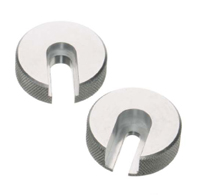
Sorbent tube storage
Conditioned or sampled sorbent tubes should always be capped using ¼" brass Swagelok type screw caps fitted with combined PTFE ferrules (p/n C-CF020) as recommended by international standard methods for thermal desorption. We recommend the tubes to be tightened using a Markes CapLok™ tool (p/n C-CPLOK) or using conventional spanners / wrenches. The Cap-Lok tool was invented by scientists and makes it easier to cap tubes in the lab or field.
 The CapLok tool also prevents over-tightening and distortion of the PTFE ferrules. Capped conditioned or sampled tubes should always be stored in as clean an atmosphere as possible. As an additional precaution batches of clean or sampled tubes can be wrapped in uncoated aluminium foil and placed in clean, nonemitting, air-tight containers such as unused paint cans, or freezer-grade food storage containers during transportation or extended storage.
The CapLok tool also prevents over-tightening and distortion of the PTFE ferrules. Capped conditioned or sampled tubes should always be stored in as clean an atmosphere as possible. As an additional precaution batches of clean or sampled tubes can be wrapped in uncoated aluminium foil and placed in clean, nonemitting, air-tight containers such as unused paint cans, or freezer-grade food storage containers during transportation or extended storage.
It is not necessary to store capped tubes (blanks or sampled) in refrigerated conditions - unless the sampled tubes contain more than one sorbent. In this case, refrigeration is recommended to minimise risk of middle volatility analytes migrating from weaker to stronger sorbents during storage and thus resulting in incomplete recovery during analysis. If refrigeration is used, the caps must be retightened using the Cap-Lok tool once they have reached their storage temperature. Refrigerated tubes must also be removed from the freezer/refrigerator and left to equilibrate with the laboratory temperature before the storage caps are removed for analysis. If the tubes are uncapped while they are still cold, humidity from the lab air can condense inside the cold tube causing subsequent analytical difficulties.
Be aware that that the air within many general-purpose laboratory fridge / freezers is highly contaminated with volatiles from other samples or from the refrigeration system itself. Note also that if tubes are to be transported in such a way as to be exposed to very cold temperatures i.e. in an aircraft hold, by rail/ road overnight during cold weather, it is advisable to follow the above retightening procedure by cooling the tubes prior to shipment and retightening the caps.
Reference: This information is a part of Thermal Desorption Technical Support document TDTS Note 5 by Markes International.





 0
0
 0
0